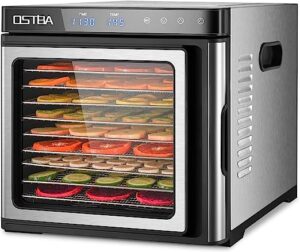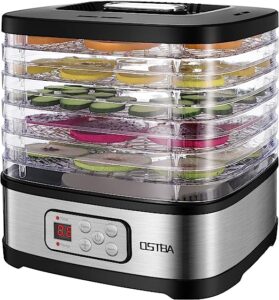Food Dehydrators: Preserve Nutritiously
Food dehydrators preserve nutritiously and are an essential kitchen appliance for anyone who loves to preserve food while retaining its nutritional value. As an avid enthusiast when it comes to food dehydrators, I’m excited to share the numerous benefits, tips, and suggestions to help you make the most out of this fantastic kitchen tool.
What is a Food Dehydrator?
A food dehydrator is a device designed to remove moisture from various foods, such as fruits, vegetables, herbs, and meats, through a controlled drying process. By eliminating moisture content, a food dehydrator allows you to extend the shelf life of food while retaining its essential nutrients, flavors, and textures.
Benefits of Using a Food Dehydrator
Preserves Nutritional Value
When you dehydrate food, you preserve its nutritional value. Unlike traditional preservation methods like canning or freezing, which may result in nutrient loss, dehydration helps retain vital vitamins, minerals, and enzymes found in fresh produce.
Extends Shelf Life
Food Dehydrators preserve nutritiously by removing moisture and significantly extending the shelf life of food items. Dehydrated foods can last for months or even years when stored properly in airtight containers. This is especially useful for gardeners, hikers, and anyone looking to reduce food waste.
Reduces Food Waste
Food dehydrators are excellent tools for reducing food waste. Instead of letting your fruits, vegetables, or herbs go bad, you can dehydrate them and enjoy their flavors and nutrients long after their peak freshness.
Types of Food Dehydrators
There are different types of food dehydrators available in the market, each with its unique design and functionality. Here are three common types:
1. Stackable Tray Dehydrators
Stackable tray dehydrators consist of multiple trays that can be stacked on top of each other. These dehydrators are ideal for beginners and those with limited kitchen space. They are easy to use and allow for even airflow between the trays, ensuring uniform drying.

2. Vertical Flow Dehydrators
Vertical flow dehydrators feature a vertical airflow system that distributes hot air evenly throughout the unit. This design prevents flavors from mixing and allows for efficient drying. Vertical flow dehydrators are suitable for preserving a wide range of foods, including delicate herbs and spices.

3. Box and Shelf Dehydrators
Box and shelf dehydrators are larger, freestanding units that resemble a mini oven. They have multiple shelves or trays and provide ample space for drying larger quantities of food. These dehydrators often come with adjustable temperature controls and timers for precise drying.

Factors to Consider When Choosing a Food Dehydrator
When selecting a food dehydrator, it’s essential to consider several factors to ensure you make the right choice for your needs. Here are some key considerations:
1. Size and Capacity
Determine the amount of food you plan to dehydrate regularly and choose a dehydrator with an appropriate size and capacity. Consider both the dimensions and the number of trays or shelves available.
2. Temperature Control
Look for a dehydrator that offers adjustable temperature control. Different foods require different drying temperatures, and having control over the heat settings will allow you to achieve optimal results.
3. Airflow and Drying Mechanism
Ensure that the dehydrator you choose has proper airflow and ventilation systems. Good airflow is crucial for consistent and efficient drying. Look for models with fans or vents that distribute heat evenly.
4. Ease of Use and Cleaning
Consider the user-friendliness of the dehydrator. Look for features like intuitive controls, easy tray or shelf removal, and dishwasher-safe components for hassle-free cleaning.
Popular Food Dehydrator Brands
Several reputable brands offer high-quality food dehydrators that have gained popularity among enthusiasts. Here are three well-regarded brands:
1. Excalibur
Excalibur is a renowned brand known for its durable and reliable food dehydrators. They offer a wide range of models with varying capacities, adjustable temperature controls, and excellent airflow systems.
2. Nesco
Nesco is another trusted name in the food dehydrator market. They offer affordable and efficient dehydrators suitable for both beginners and experienced users. Nesco dehydrators often feature innovative technologies such as Converga-Flow® drying systems for even drying.
3. Presto
Presto is a popular brand that offers affordable yet efficient food dehydrators. They provide a range of options with various capacities and temperature controls. Presto dehydrators are known for their simplicity and ease of use.
Tips for Using a Food Dehydrator
To ensure successful dehydration and optimal results, follow these tips when using your food dehydrator:
1. Prepare Food Properly
Before placing your food in the dehydrator, make sure to wash and thoroughly dry it. Remove any bruised or damaged parts and slice fruits and vegetables evenly for uniform drying.
2. Arrange Food Evenly
Properly space out your food items on the trays to ensure adequate airflow. Avoid overcrowding, as it can hinder the drying process. Leave enough room for the air to circulate freely.
3. Check for Dryness
Regularly check the food for dryness during the dehydration process. The time required for drying varies depending on the food and the dehydrator model. Follow the recommended guidelines and conduct periodic checks to prevent over or under-drying.
4. Proper Storage
Once your food is completely dehydrated, allow it to cool before storing it in airtight containers or vacuum-sealed bags. Store the containers in a cool, dark place away from moisture and direct sunlight to maintain the quality and freshness of the dehydrated food.
Recipes and Foods to Dehydrate
Food dehydrators offer endless possibilities for creating delicious and nutritious snacks. Here are some food items that are commonly dehydrated:
1. Fruits and Vegetables
Dehydrated fruits like apples, bananas, and berries make for tasty and portable snacks. Vegetables such as tomatoes, peppers, and kale can be dried for later use in soups, stews, or as flavorful additions to meals.
2. Herbs and Spices
Dehydrating herbs like basil, rosemary, and thyme helps preserve their flavors for extended periods. Spices like chili peppers and garlic can also be dehydrated and ground into powders.
3. Meat and Jerky
Food dehydrators are excellent for making homemade jerky from beef, poultry, or even fish. Dehydrating meat removes moisture, making it safe for long-term storage without refrigeration.
4. Nuts and Seeds
Dehydrating nuts like almonds, cashews, and walnuts can enhance their crunchiness and extend their shelf life. Seeds such as pumpkin seeds or sunflower seeds can be dehydrated and used as nutritious toppings for salads or snacks.
Maintenance and Care for Your Food Dehydrator
To keep your food dehydrator in optimal condition and ensure its longevity, follow these maintenance and care tips:
1. Cleaning and Sanitizing
Regularly clean your dehydrator by removing trays, racks, or shelves and washing them with warm soapy water. Wipe the interior and exterior of the dehydrator with a damp cloth. Sanitize the removable parts after washing to eliminate any bacteria or mold.
2. Storage
When not in use, store your food dehydrator in a clean and dry environment. Keep it away from direct sunlight or excessive heat to prevent any damage.
3. Replacing Parts
If any parts of your dehydrator become damaged or worn out over time, it’s important to replace them promptly. Check the manufacturer’s instructions or contact customer support for guidance on obtaining replacement parts.
Conclusion
Food dehydrators preserve nutritiously and are versatile kitchen tools that offer numerous benefits for preserving and enjoying food. By dehydrating fruits, vegetables, herbs, and meats, you can extend their shelf life while retaining their nutritional value. Consider the different types of dehydrators, factors to consider when choosing one, and popular brands in the market. Follow the tips provided for optimal dehydration results, and explore various recipes and food items to dehydrate. With proper maintenance and care, your food dehydrator will continue to serve you well, providing delicious and healthy snacks for years to come.
FAQs
- Can I dehydrate frozen fruits and vegetables? Yes, you can dehydrate frozen fruits and vegetables. However, it’s best to thaw them before placing them in the dehydrator for more efficient drying.
- How long does it take to dehydrate food? The drying time varies depending on the type of food, moisture content, and the dehydrator model. It can range from a few hours to several days.
- Can I dehydrate different foods simultaneously? Yes, you can dehydrate different foods simultaneously as long as they require similar drying temperatures and have similar moisture levels.
- What is the recommended temperature for dehydrating food? The recommended temperature for dehydrating food typically ranges from 120°F to 160°F (50°C
